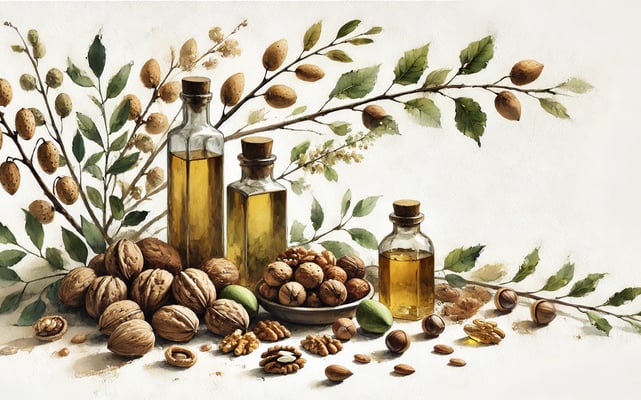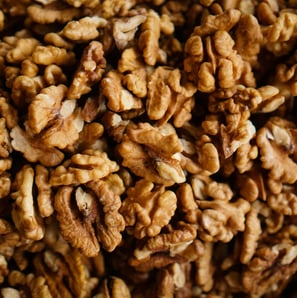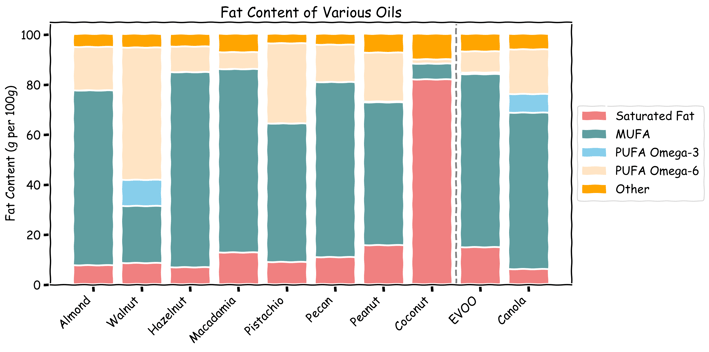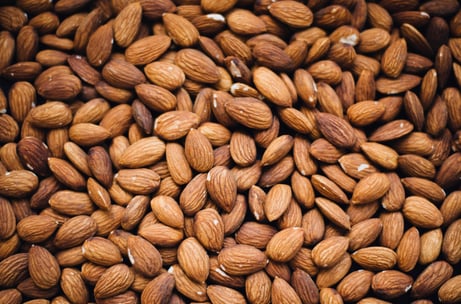Explore Nut Oils Benefits
Discover the health effects of various nut oils for a healthier, happier lifestyle.


Why Nut Oils
You should eat more nuts! They are a nutrient-rich food providing healthy fats, proteins, fiber, vitamins, and minerals in one wholesome package. Our ancestors have been eating nuts for thousands of years. Even nowadays, when most people have access to a huge variety of foods, there are plenty of reasons to stick to nuts as a part of a diverse and balanced diet. Scientific studies have found that eating nuts has many benefits: they help regulate cholesterol levels, reduce inflammation, lead to better weight management, and even improve brain function! Regularly consuming nuts reduces your risk of multiple diseases, most notably heart and cardiovascular problems, metabolic diseases such as Type 2 diabetes, and cognitive disorders. There is also strong evidence that nuts reduce your cancer risk overall, especially the risk for cancers of the digestive system.
Nuts are great for you, but beyond snaking, there are only so many ways to incorporate them into your diet. Fortunately, there is another option for accessing some of the essential goodness of nuts – nut oils! The oils extracted from nuts contain many of the same healthy nutrients: the “good” fats, many powerful antioxidants, and minerals like zinc and selenium. Using nut oils is an alternative way to add this ancient and nourishing food to your diet. Note, however, that while the oils – especially the minimally processed, unrefined ones – retain much of the healthy components of the original nuts, they dispose of the fiber, most of the proteins, and some other beneficial compounds. So treat them as an addition to – not a substitute for – your regular portion of nuts.
With nut oils, we can also do things that would be impossible with whole nuts. The oils can be used externally as natural skin and hair care products. They are great skin moisturizers and have potential anti-aging applications. Some nut oils can improve hair health and strength. Because of their anti-inflammatory and anti-microbial effects, nut oils can even treat problems like eczema and dandruff.
The health benefits are only one reason why nut oils are becoming increasingly popular in kitchens around the world. Their taste is another; because of their rich nutty flavors, they can enhance the taste profiles of many dishes. While few of them – walnut oil, for example – should be restricted to low-temperature uses for things like salads and finishing, some nut oils can be used during cooking.




Photo by Tom Hermans | Unsplash
Photo by Bruno Guerrero | Unsplash
Types of Nut Oils
Minor components
The smoke point is the temperature at which an oil starts to smoke. It is a common measure of how stable an oil is when cooking with it – the general rule of thumb is not to heat an oil close to – and certainly not above – its smoke point. Due to the differences in fat composition, the smoke points vary quite a lot: the figure below shows that. To make things even more complicated, how processed is an oil (in particular, is it refined) also affects its smoke point. Refined oils are more stable under heating but also lack many of the health benefits of unrefined oils (because refinement removes many of the beneficial minor components).
Smoke point
Fat content
Here are some nut oils you can easily buy online or in a good grocery store:
Hazelnut Oil
Macadamia Oil
Pistachio Oil
Pecan Oil
Brazilian Nut Oil
Cashew Oil
Peanut Oil
Coconut Oil
Pine nuts Oil
As you can see, there are a lot of different oils. While some of them – such as peanut and coconut oils – have been staple cooking items for a long time, others are just gaining popularity. Yet others are probably going to stay rarely used exotic items. (What is a true nut in the botanical sense is a bit complicated. For example, from the nuts above only walnuts and hazelnuts are true nuts, peanuts are legumes, and almonds and coconuts are something called drupes. Regular people – meaning non-botanists – tend to ignore these subtle points, and most true nuts and other “nuts” are commonly lumped together as “culinary nuts”)
These oils offer an enormous variety of uses, flavors, and benefits. Just as the nuts from which they come, each nut oil has its unique character. Beyond the obvious things like taste and price, the oils differ in their fat compositions, smoke points, minerals, and vitamin contents, as well as the many (proven as well as conjectured) health benefits. You need to know something about these oils to get the full advantage of the benefits they bring.
Obviously, oils are mostly fat. There are different types of fat, however: for a very short discussion of these fats, how they differ, and why it matters see the page on fats. The fat composition of nut oils reflects the variety of the nuts from which they originate. The figure on the right shows how some popular nut oils stack in terms of saturated, monounsaturated, and polyunsaturated fats (the more accurate term is fatty acids, not fats, which is why the last two are commonly abbreviated as MUFA and PUFA, respectively). The PUFAs are split into omega-3 and omega-6 since these offer distinct health benefits. For comparison, Extra Virgin Olive Oil (EVOO) and canola oils are also shown.




While fat is their main component, nut oils also contain many other bioactive ingredients that contribute to their overall health benefits. Some of the most important ones are:
Tocopherols (Vitamin E family) - powerful antioxidants that protect the cells from oxidative damage which can lead to premature aging and chronic diseases
Phytosterols – these compounds block the absorption of cholesterol in the intestines and reduce the risk of heart disease
Polyphenols – another group of antioxidants that help fight inflammation and protect the body from various chronic diseases
Vitamin B complexes (B1, B2, B3, B6) - essential for energy metabolism and nervous system function
Minerals (for example, magnesium, copper, potassium, selenium) - vital for many bodily functions, including enzyme reactions and electrolyte balance.


MUFA is the dominant fat for most of the nut oils, with PUFA and saturated fats playing only secondary roles. There are two big outliers. The first one is walnut oil - it is mostly PUFA with more than 10% omega-3. Few other oils can match its omega-3 content – canola oil is close, and flaxseed oil has more than 50% omega-3, but that’s about it. Omega-3s are essential PUFA that are connected to multiple health benefits, especially for the cardiovascular system. Unfortunately, most people don’t consume enough of them. A common way to add omega-3s to your diet is by eating fatty fish or fish oil, but for the millions of people for which this is not an option, walnuts, and walnut oil offer great alternatives.
Coconut oil is on the other extreme - it is almost entirely saturated fat. (This is the reason it is solid at room temperature.) Now, saturated fats are typically considered bad – eating them tends to increase the level of LDL (“bad”) cholesterol, which in turn increases the risk of things like heart attacks. However, the saturated fats in coconut oil are a very specific type (mostly lauric acid) and it is unclear if they are as problematic as the saturated fats in animal products.
The rest of the oils look similar to EOOV (and canola oil) in their fat composition, and this is great news – EOOV is considered a very healthy general-purpose oil. However, a key reason for the health benefits of EOOV is some of the other – non-fat – components such as polyphenols, extracted from the olives. Nut oils – especially the unrefined ones – also have polyphenols and other healthy stuff coming from the nuts.


Photo by Joanna Kosinska | Unsplash
Photo from Unsplash
Uses of nut oils
The use of nut oils in cooking is mostly determined by three things: flavor, smoke point, and price. Flavor is a subjective thing – what one person thinks is mild can be overwhelming for another. Still, the general opinion is that almond, macadamia, peanut, and pecan oils are on the mild flavor side, while walnut, hazelnut, pistachio, and coconut oils have a more robust, strong flavor. Combining this with the smoke points of various oils, the general recommendation is:
Finishing/Salad dressing: while walnut and hazelnut oils are not great for cooking due to their low smoke points, they can be used to finish a dish or salad by adding a rich buttery flavor
Baking/light sautéing: Almond and macadamia oils have intermediate smoke points and can tolerate some moderate heat. Also, because of their relatively mild flavor, they would not overpower the taste of the other ingredients in a dish
Frying: Pecan oil has a very high reported smoke point (it comes from a single paper, so still use it with caution);
(Note that the refined peanut oil has a much higher smoke point and is commonly used for deep frying. Here we are mostly interested in unrefined oils.)
Cooking
Nut oils are not only great as food but are also excellent skin and hair care products. They can be used as skin moisturizers, and some are known to improve hair health and strength. Some nut oils (walnut and almond oils, for example) also show anti-microbial and anti-inflammatory effects, which can be good for treating skin and hair problems.
Coconut oil is perhaps the most widely used nut oil in beauty routines. Many studies have shown that coconut oil can effectively hydrate the skin and reduce water loss. It can also penetrate the hair shaft, reducing protein loss and preventing damage. There is some (not conclusive) evidence that coconut oil has antimicrobial effects, potentially helping with dandruff.
Macadamia oil is similar in composition to human sebum (the substance that protects and hydrates your skin's surface). Because of this macadamia oil is very effective in hydrating the skin. There are even some tentative claims it can be used in anti-aging by reducing the appearance of fine lines.
Both almond oil and walnut oils are commonly used to hydrate dry, mature skin. Studies have shown almond oil (high in vitamin E) can improve dry skin, reduce inflammation, and soothe irritated skin. Walnut oil also is used in anti-aging skincare products to improve elasticity, reduce wrinkles, and even treat skin conditions like eczema.
It is important to distinguish between clinically proven effects and claims from social media and anecdotal stories. While nut oils' moisturizing properties are well established, as with any skin care or hair care product, individual results may vary.
Hair and skin care




Photo by Anton Malanin | Unsplash
Photo by Christin Hume | Unsplash
Questions
Are nut oils good for me?
Yes, nut oils can be a healthy addition to your diet. They are a concentrated source of many off the healthy fats, vitamins, and antioxidants present in nuts. They are not a substitute for whole nuts, though, mostly because they lack fiber. Nut oils are also very energy-dense, so be careful not to consume too much.
Nut oils are also great natural skin and hair products.
Can I cook with nut oils?
Yes, provided you don’t heat them above their smoke point. Since walnut and undefined peanut oils have a low smoke point, they should be used for salad dressing, finishing, and low-temperature cooking. Almond, macadamia, and pecan oils can be used for moderate-heat cooking.
Which is the best nut oil?
It depends on the application and your personal preferences. Each nut oil offers a unique combination of flavor, content, price, and health benefits.
Can I get an allergic reaction from a nut oil?
Unfortunately, yes. Unrefined – the generally healthier – nut oils can cause allergic reaction in sensitive people. In contrast, refined nut oils are considered safe for most people with nut allergies. For example, highly refined peanut oil does not require allergen labeling, but it is recommended that those with peanut allergies avoid consuming unrefined peanut oil, since it contain peanut proteins. There is limited data on the use of nut oils topically, on the skin and hair, but it is safer to avoid these as well. The potential risk depends on the specific oil, the processing method, the application and individual’s sensitivity, so it is best to consult an alergenits before using an oil coming from an known allergenic nut.
Sources
For the benefits of nuts:
“Health Benefits of Nut Consumption”, Emilio Ros, Nutrients (2010)
For the connection between the connection between nuts consumption and reduced risk of cancer, see, for example:
"Association of Total Nut, Tree Nut, Peanut, and Peanut Butter Consumption with Cancer Incidence and Mortality: A Comprehensive Systematic Review and Dose-Response Meta-Analysis of Observational Studies", Naghshi S et al., Advances in Nutrition, (2023)
For the cognitive health benefits of eating nut, see, for example:
"Nut Consumption for Cognitive Performance: A Systematic Review", Theodore LE et al., Advances in Nutrition, (2021)
For the fat content of various nut oils, I have used:
For the minor components, see:
“Composition of Nuts and Their Potential Health Benefits—An Overview”, Berta Gonçalves et al. Foods, (2023)
For smoke points, I used data collected in:
Get in Touch
We welcome your inquiries about nut oils and their health benefits. Contact us for more information.
Health
Discover the benefits of various nut oils today.
Explore
contact@nutguide.com
© 2024. All rights reserved.
